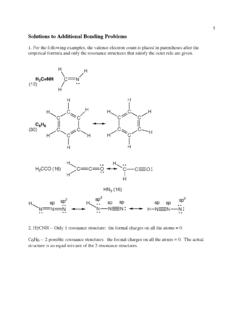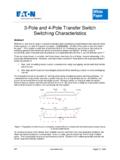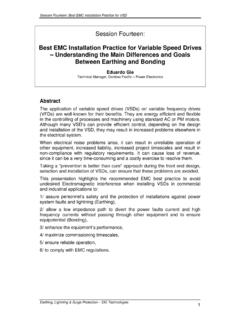Transcription of Solving the Problem of Adhesion to Plastics & Rubber
1 WP1206 Dyne Technology Limited 2005 - 2012 Page 1/4 Solving THE Problem OF Adhesion TO Plastics & Rubber . By Chris Lines, Managing Director, Dyne Technology Ltd. WHY IS BONDING TO Plastics AND Rubber SO DIFFICULT? The age old Problem of obtaining good Adhesion of paints, coatings, sealants and glues to traditionally hard to bond to materials like polypropylene has challenged engineers ever since its development and introduction by ICI in the late 1930 s. Examples of the materials in question are Polypropylene (PP), Polyethylene (PE), High-Density Polyethylene (HDPE), EPDM, all of which have low surface energies of between 29 36 Dynes/cm (mN/m).
2 Achieving any level of Adhesion to low surface energy materials , , is difficult at the best of times and sometimes near impossible, basically these materials are non-stick; printing inks rub off, glued parts fail, gaskets and seals won t bond, paint & coating will not adhere. Typically these problems are experienced throughout the automotive industry, medical device manufacturing industry and in fact in any industry that has to bond, print, or coat plastic or Rubber components. These problems are becoming increasingly commonplace with the increase in usage of polyolefins. Generally polyolefins have what is called low surface energy or non-polar surfaces and no matter how much you attempt to clean or abrade the surface they remain hard or often impossible to paint, coat, print or bond to without resorting to harsh, environmentally damaging chemicals or high temperature flame torch treatments.
3 This Problem was recently experienced by a major UK automotive sub-supplier when they attempted to glue coverings to a range of polypropylene (PP) door panels and other internal passenger compartment parts. The PP injection moulded components were sprayed with an adhesive and then the covering applied. On testing, the finished parts failed due to very poor bond strength between the adhesive and the PP surface of the components, the coverings simply peeled off. To make things worse, the ever increasing drive towards the use of UV curing or water based adhesives, paints, inks & coatings means that even materials that have traditionally given WP1206 Dyne Technology Limited 2005 - 2012 Page 2/4 acceptable bonding results ABS, Nylon (PA) Glass Filled Nylon and Composites to name but a few, can also become difficult to bond to.
4 This Problem was highlighted earlier this year at another major UK automotive component manufacturer when they introduced a new product moulded from Glass Filled Nylon and needed to apply a water based paint to give a car body matching paint finish. Quickly the company realised that the paint finish was failing their customer s paint Adhesion test. Along with gluing and painting, printing on to Plastics often presents a similar Adhesion issue, this can be critical on medical devices or where high print quality is required syringe marking, barcodes etc. The strength of attraction between a material and a coating is determined by the relative surface energy and surface tension of the materials.
5 The higher the solid s surface energy relative to the liquid s surface tension, the greater the molecular attraction; this draws the paint, ink or adhesive closer for high bond strength. The lower the solid s surface energy relative to the liquid s surface tension the weaker the attractive forces are; this will repel the coating. The challenge faced by producers of extruded or injection moulded components is to increase the surface energy (polarity) of the material to a level significantly higher than that of the surface tension of the paint, coating, adhesive or printing ink, so that the surface acquires a strong chemical attraction to paints, coatings, sealants, adhesives etc.
6 Leading to significantly enhanced wetting and Adhesion . Typically the Surface Energy of the substrate will need to exceed the Surface Tension of the ink, paint, coating or adhesive by at least 10 - 15 Dynes/cm (mN/m). WP1206 Dyne Technology Limited 2005 - 2012 Page 3/4 HOW CAN BOND PERFORMANCE TO Plastics AND Rubber BE IMPROVED? Firstly, we need to understand what surface properties are required to obtain the ideal conditions for Adhesion . There are many common misconceptions on what are the best conditions required for the strongest bond, should the surface be heated?
7 Abraded? solvent wiped? Sometimes these pre-treatments do no harm and may on some occasions even help a little, however, it is widely recognised that the ideal surface to bond to should be: Clean Dry Dust free Smooth Non-porous Wettable (high surface energy) Polar Preparing a clean, dry, dust free, smooth and non-porous surface requires little discussion, however, creating a surface that exhibits good wettability and is polar clearly does. There are several methods of increasing the Surface Energy and Polarity of Plastics and rubbers, they include: wet chemical treatments which are often harsh and environmentally damaging, high temperature flame torch treatments, high voltage corona treatment and finally plasma surface activation which we will discuss in this edition.
8 PLASMA SURFACE ACTIVATION. Exposing low surface energy extruded or injection moulded components to the highly active environment of either vacuum or atmospheric plasma is a very effective and long lasting method of increasing their surface energy and polarity. The component undergoes a very efficient surface treatment that is environmentally friendly, does not alter the bulk properties of the treated part and does not mark or discolour it in any way. The resulting highly activated surface will now have the required high surface energy and polarity necessary to ensure good wetting and Adhesion of printing inks, paints, adhesives, coatings, potting materials etc.
9 Plasma surface modification is widely used throughout a diverse range of industries and onto an ever increasing range of substrates. In simple terms, plasma is generally described as a super ionised gas or as an electrically neutral medium of positive and negative particles and neutrals (atoms, radicals & WP1206 Dyne Technology Limited 2005 - 2012 Page 4/4 molecules) and can react with a wide range of materials. "Ionised" refers to the presence of free electrons which are not bound to an atom or molecule. Plasma is created when a gas is subjected to a high energy discharge; the gas breaks up into electrons, ions, highly reactive free radicals, short wave UV light photons and other excited particles.
10 In general terms, when you subject atoms or molecules to enough energy, what happens very quickly is that the electrons around the nucleus start to "boil off", the temperature becomes too high for them to stay contained in orbit around the nucleus. Plasma is not new; it was first described by Sir William Crook way back in 1879 and is the most common type of matter in the known universe whether measured by mass or volume. Every star is a giant ball of plasma, even the space between all of the stars is composed of plasma. Plasma is considered to be the 4th state of matter after solid, liquid & gas.







